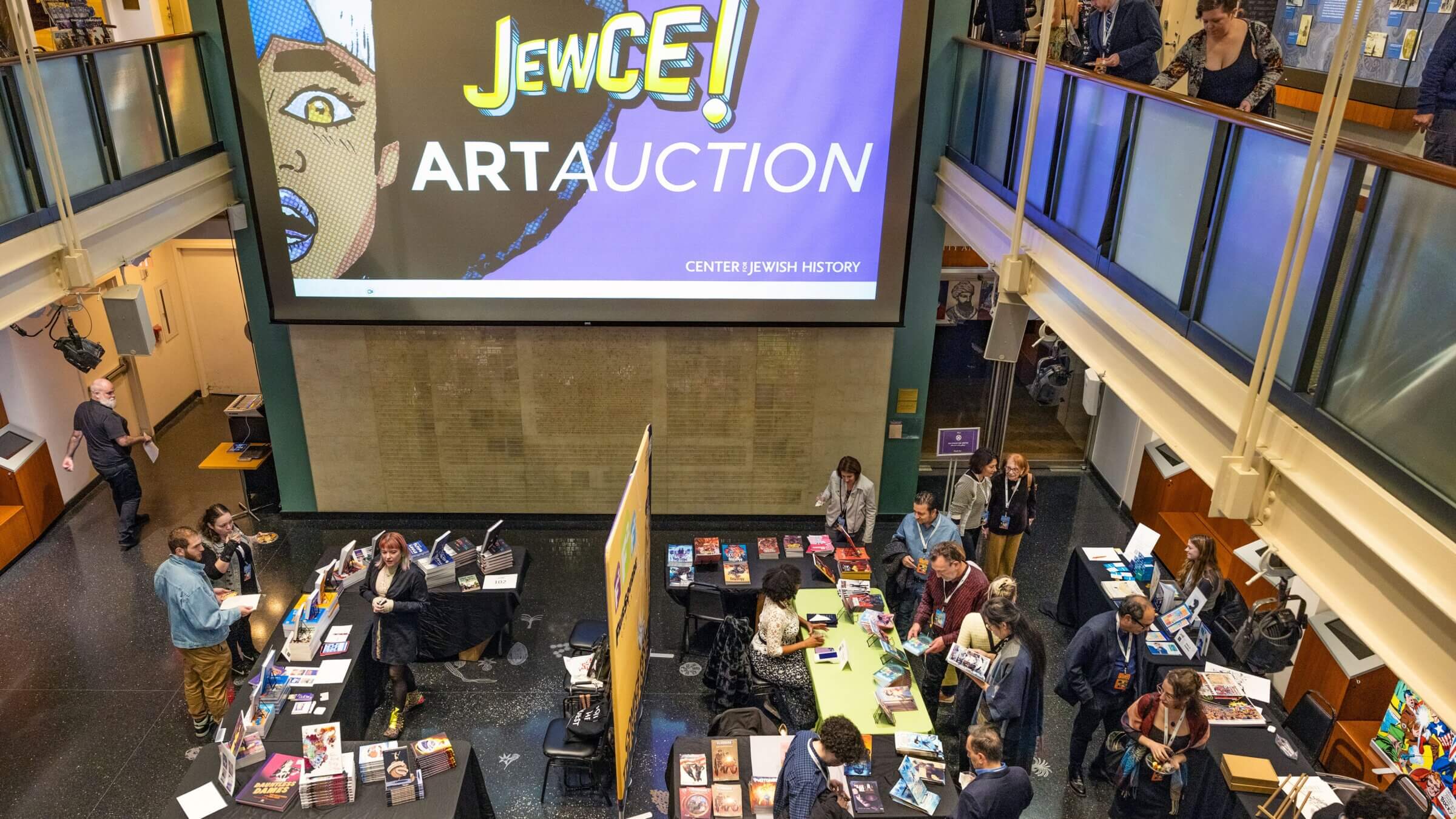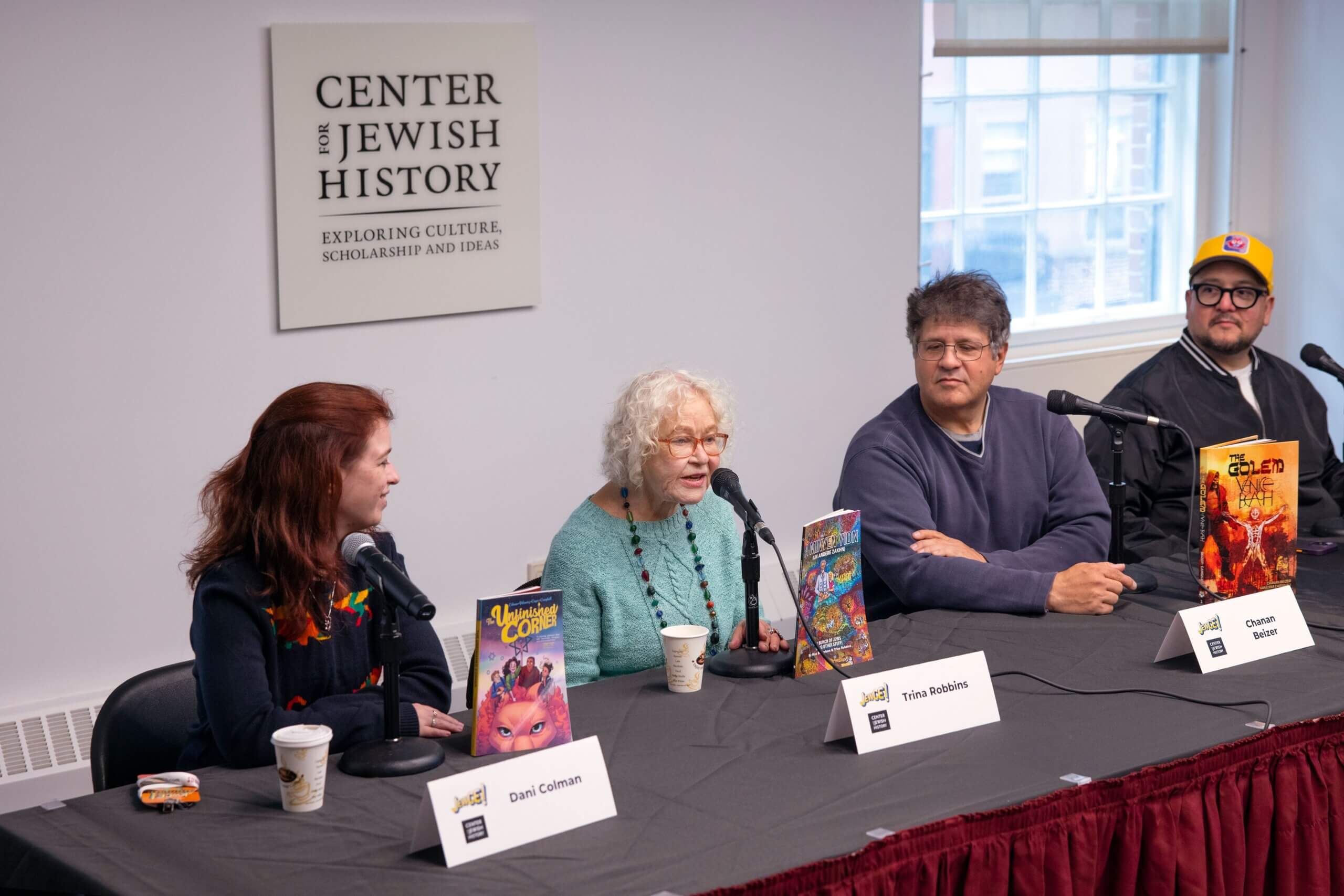Talmudic debates, space bar mitzvahs and Frank Miller’s Jewish plans for Superman
The JewCE Jewish comic convention saw over 400 enthusiasts flock to the Center for Jewish History

The scene from JewCE, the Jewish Comic Experience convention. Photo by John Halpern
The scene was familiar to anyone who’s ever been to a panel at a comics convention, or seen a certain classic William Shatner sketch — an audience member was asking a very specific question about one tiny element of a comic.
“In your Superman run, I think in issue #13, there’s a line from a character,” a young man asked comic book writer Brian Michael Bendis, co-creator of beloved Marvel characters Miles Morales and Jessica Jones. “He’s talking to a bunch of other aliens at a council and he says ‘I had my chief science officer leave his cousin’s bar mitzvah to check some of your readings.’ And I’m wondering if this is a retcon to bring Judaism to alien cultures?”
Bendis, an alumnus of the Hebrew Academy of Cleveland, was Zooming in for a panel about “retroactive continuity,” the term for when creators change the established facts of a character or storyline after the fact. He joked that if someone read his Guardians of the Galaxy run, where The Thing and Kitty Pryde were sent into orbit, they’d know there are Jews in space and, thus, bar mitzvahs.
“I’m very aware I’m standing on the shoulders of great Jewish writers who created the greatest Jewish characters of all time,” Bendis added, earnestly. “It’s a cheeky line, but at the same time, yeah, I’m saying ‘We’re here, we’re living, we’re celebrating.’”
In other words, Am Yisrael Chai.
The venue for this exchange was the Center for Jewish History in Manhattan, where, on Sunday, over 400 people, from toddlers to retirees, gathered for JewCE: The Jewish Comics Experience’s convention. If most comic cons have a lot of Jewish fans already, this event was explicitly crafted to unearth the form’s Jewish subtext and to acknowledge the creators who birthed the comics industry — this, even when many Jews feel shaken by world events.

“It was always important to me to have an event that celebrated the Jewish roots of comic books, and that was also celebrating the diversity and the vitality of Jewish content in graphic novel form,” said JewCE co-creator Fabrice Sapolsky, an artist and writer for Spider-Man and Image Comics, who also edits and publishes comics, including a new series with the first Asian Jewish woman superhero.
Sharing a very Jewish history
Sapolsky held a Jewish comic con in 2016 and 2018 at a synagogue in Crown Heights, but joined with the Center for Jewish History’s Director of Academic and Public Programs Miriam Mora earlier this year to launch a fuller version of the convention alongside an exhibition on Jewish comic book history. This partnership allowed for more programming and tighter security — especially important, Sapolsky said, since the war between Hamas and Israel and the protests that arose in its wake.
But, Sapolsky said, JewCE was never meant to be political.
“We’re showing who we are,” Sapolsky told me. “We’re showing culture, we’re showing a peaceful, inclusive event, we’re showing our colors.”
Sapolsky invoked the Jewish concept of zachor, the need to remember the deep Jewishness behind a medium that grew from low art churned out by poor immigrants into a multi-billion dollar industry.
Mora, sporting a Magneto (Jewish) and a Wolverine (Canadian) earring on the main floor of the convention, emphasized the joy of the event in a difficult moment.
“The idea behind it was that we could celebrate something worth celebrating,” Mora said, amid a sea of artists’ tables for books as varied as a graphic memoir about Jewish sleepaway camp and a New York-themed Haggadah. “My hope, especially after the events in October, is that we can create a safe space for joy.”

Comic conversations turn Talmudic
In many respects, joy took the form of that most crucial of Jewish values: education, along with its regular adjunct, spirited debate.
In conversations featuring comic book legends Trina Robbins and Frank Miller, panelists argued fiercely for the Yiddishkeit of certain characters. Miller insisted that Superman was Jewish — and so was Spider-Man. Pulitzer-winning cartoonist and writer Jules Feiffer insisted he was the one who “blew the cover on Superman and wrote about Siegel and Shuster’s hero being Jewish.”
Everyone agreed The Thing was Jewish — and a golem — even if it took until the early 2000s for his origins to be revealed. “Yancy Street was always Delancey Street,” Trina Robbins said of Ben Grimm’s canonical home.
Former rabbinical student and comic author J.T. Waldman explained how he used a Talmudic process to translate holy text to images. (He drew a gasp when he said the words of God might fit best “in the gutter,” before explaining that that was the term of art for the space between the panels.)
Tod Shapiro, 64, came with his son Eric, 33. He had raised his son with Marvel comics, reading them almost as bedtime stories. Coming out of a panel with Frank Miller, who is Catholic, he explained how the Sin City creator “understands and pays homage to the Jewish philosophy and ethics in all of the work that he does.”
Eric added that there was something very Jewish in this transmission of comic fandom and of Jewishness from generation to generation. “I probably absorbed at a pretty young kid some very Jewish themes just reading the early ’60s Silver Age Marvel and some DC Comics as well.”
Behind him, Captain America co-creator Joe Simon’s grandson was educating tweens about his grandfather’s legacy — and his lawsuits with Marvel Comics.
Not many costumes, a lot of kippot
Throughout the two floors of the convention, one saw more tzitzit and kippot (one with a knit Captain America insignia) than costumes. A notable exception was a Jewish comic historian named Sasha, who dressed up in the white and blues of Israeli superhero Sabra to “piss off the antisemites.”

But in the panel discussions I attended, antisemitism wasn’t often raised. And though there was a panel on comics of remembrance, the emphasis was much more about Jewish life — in all its diversity — than death.
When Jew hatred did come up, it was often in the context of a longer history and the reasons why Stan Lee (né Stanley Lieber) and Jack Kirby (Jacob Kurtzberg) had to change their names and code their Jewish characters.
“I really do believe that America is profoundly a work in progress and that it is a mission of ours and a duty of ours to redress this,” Miller said. “Part of that, along the way, is I think Superman has gotta be a Jew.” Miller even teased that, should he write Superman again, he would make that happen.
Last week Miller drew his Sin City character Marv in an artwork captioned “stop antisemitism,” which was auctioned at the convention, and posted it to Instagram — a public statement of support an audience member thanked him for.
Many of the attendees and artists I spoke with — an event volunteer who hosts a “Jewish nerdy” podcast, teen girls who attend a day school and took copious notes on a panel about Jewish origins of the industry, a Jewish feminist cartoonist hoping to learn from veterans like Trina Robbins, Barbara Slate who published over 60 issues of Marvel’s Barbie comic and made her a feminist long before Greta Gerwig — didn’t mention Israel, preferring to chat about how Jewishness shaped the things they loved.
Only a few comics for sale, such as Miriam Libicki’s visual essay on IDF soldiers as fetish objects and some IDF-themed superhero books, addressed the Jewish state’s military. Many more highlighted Jewish holidays, the Jewish history of piracy and cybernetic sharks (with a freebie comic on Samson).
One of the final panels connected the dots between biblical inspiration and actual biblical text.
Jordan B. Gorfinkel, “Gorf,” a writer for Batman who drew an illustrated Haggadot, asked some tough questions about how to grapple with holy words in a graphic medium which, itself, may run afoul of the prohibition on graven images.
Gorf adjourned the crowd at 6:30 pm with an “Am Yisrael Chai. Hashtag bring them home now.”
But the convention, which differed from a typical con in its catering of kosher falafel, its occasional Talmudic exegesis and overhead euphemistic names for the almighty, surpassed the traumas of the outside world, to something above it — something super.
“Storytelling is part of Jewish culture,” said Sapolsky, noting how the Talmud and Midrash use stories to illustrate principles and lessons. “It’s our version of becoming a beacon and the light guiding nations.”
























